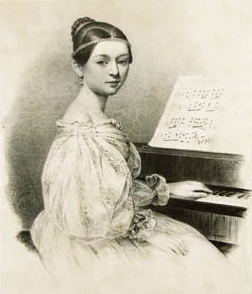
About the Piece
Instrumentation: There are two versions
Full Orchestra version (2222-2200, timp, strings)
String Orchestra version (ed. by de Beenhouwer & Kowalewski):
Duration: 12 min
Program Note:
Konzertsatz (concerto movement) in F minor is a piano concerto movement Clara Schumann began writing in 1847, intending to give the finished work to her husband on his birthday. Why she never completed it is a matter of speculation. The fragment is clearly labeled “Concerto”, and consists of 175 measures, with “solo” and “tutti” (orchestra) indicated in the score. In 1994, Dutch pianist Josef Beenhouwer completed the movement, and it was published by Breitkopf & Hartel. It is a work with a noble power, and one is quickly impressed by its spacious beauty.
Conductor’s Perspective
A really nice short piano concerto movement for young pianist and orchestra. The performance materials for the full orchestra version is harder to obtain, while the string orchestra version is available on imslp (see below).
In the string orchestra version, there are some fast 16th note passages for the strings, and the writing confirms with contemporary German romantic style. The coordination between the orchestra and the solo is not too tricky, and would be a great work to introduce the 19th century concerto movement style to young orchestras.
About the Composer
Clara Schumann ranks among the most important women musicians of the 19th century. She wrote songs, chamber music and the Piano Concerto in a minor op. 5, which is increasingly finding its way into the repertoire of many pianists today.
Her father Friedrich Wieck had foreseen a career as a pianist for her. He taught her and had her perform in public for the first time in 1828.She started undertaking long concert tours in 1832 and married the composer Robert Schumann in 1840 against her father’s will. During her marriage she wrote songs, chamber music and the Piano Concerto in a minor op. 7, which is increasingly finding its way into the repertoire of many pianists today. After her husband’s death in 1856 she devoted herself more intensively to her pianistic career and committed herself with a great deal of energy to her husband’s works. She also played works by Beethoven, Chopin and Brahms, with whom she maintained a profound and lasting friendship. She also edited Robert Schumann’s works and published a collection of his writings. (taken from Breitkopf & Härtel)
Performance Materials
● Full Orchestra version (2222-2200, timp, strings):
Music Rental from Wise Music Classical (USA and Canada – request through Zinfonia)
Study Score for Purchase and Performance Music Rental from Breitkopf & Härtel (Europe)
● String Orchestra version (ed. by de Beenhouwer & Kowalewski):
Score and Parts download on imslp
Recording
Recording on YouTube by the Ambache Chamber Orchestra with piano solo by Diana Ambache